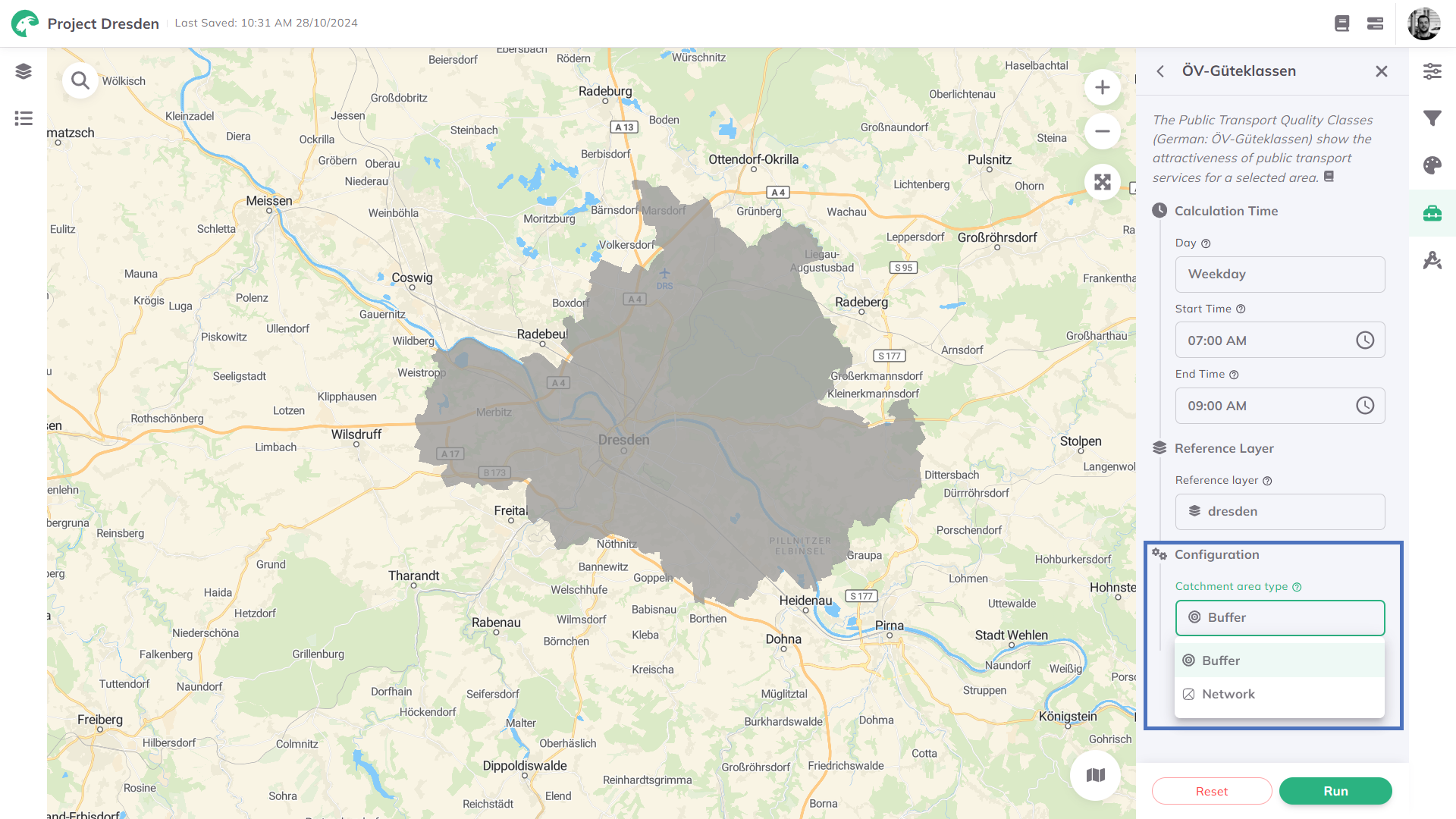ÖV-Güteklassen
The Public Transport Quality Classes (German: ÖV-Güteklassen) show the attractiveness of public transport services for a selected area.
1. Explanation
Public Transport Quality Classes, also known as ÖV-Güteklassen, are a classification system used to evaluate and categorize the quality of public transport services in a given area. The concept is used to plan and evaluate public transport services to ensure that they meet certain standards and effectively serve the needs of the population. The quality classes thereby range from A (very good offer) to F (very poor offer).

The calculation of the public transport quality classes is only available for areas where the transport network is integrated into GOAT.
In case you need to perform analysis beyond this geofence, feel free to contact the Support and we will check what is possible.
2. Example use cases
- How good is public transport supply in different parts of the city?
- How many people are underserved by public transport? Where is the need for further supply?
- How does the quality of public transport services differ at different times of the week and day?
3. How to use the indicator?
Toolbox Accessibility Indicators menu, click on ÖV-Güteklassen. This opens the settings menu.
Calculation Time
Day, Start Time and End Time, for which you like to perform the analysis.Reference Layer
Reference Layer for which you like to calculate the indicator. This can be any polygon feature layer.Configuration
Catchment area type for the calculation, which can be based on either Buffer or Network. Buffers represent areas around public transport stations measured "as the crow flies", while network catchment areas account for the same distances along real-world streets and paths.

Run. This starts the calculation of the Public Transport Quality Classes for the selected area.Depending on the size of the selected area, the calculation might take some minutes. The status bar shows the current progress.
Results


4. Technical details
Scientific Background
The quality and frequency of transit services is a decisive indicator in public transport and spatial planning. It can be used to highlight deficits in the public transport offer and to identify well-serviced locations as attractive areas for development. The approach of Public Transport Quality Classes (German: ÖV-Güteklassen) is methodologically superior compared to common catchment areas. In 2011, the Swiss Federal Office for Spatial Development (ARE) started to use the indicator of ÖV-Güteklassen to include the attractiveness of public transport services in the assessment of development quality; since then, these have been considered an important instrument in formal planning processes in Switzerland. In addition, the Swiss model served as an inspiration for application in Austria (e.g. Voralberg) and finds first application in Germany (e.g. by KCW and Agora Verkehrswende).
The institutionalization of the indicator in German-speaking countries, as well as the comprehensible and at the same time differentiated calculation methodology, are important advantages of the ÖV-Güteklassen.
Calculation
In the Swiss version of the indicator, the calculation of the quality classes is usually carried out for departures on weekdays between 6 AM and 8 PM. For the use in GOAT, the calculation period was made more flexible so that the indicator can be calculated for any day of the week and time of day. Furthermore, the indicator was adapted to the conditions in Germany.
The calculations are carried out based on GTFS data (see Inbuilt Datasets). First, the number of departures per public transport mode (train, metro, tram, and bus) is dynamically calculated for each station. The sum of the departures is divided by two to calculate the frequency, to eliminate the outward and return directions. In the next step, the average frequency for the selected time interval is calculated. The higher-value service is selected as the station type in the case of service by several means of transport. For example, in the case of buses and trains, this is the train. With the help of the table below, as well as the station type and the frequency, the station category can now be determined.

Subsequently, buffers or network catchment areas of the size shown are calculated for the corresponding station categories. This creates several buffers or isochrones that are merged. For overlapping buffers/isochrones, the higher-quality class is used.


Overview figure illustrating the calculation of the ÖV-Güteklassen
Visualization
The created buffers/network catchment areas are visualized around the stations in the corresponding colors to highlight the quality class (A-F).


5. Further readings
Sample projects where ÖV-Güteklassen was used:
- Germany-Wide Assessment of Public Transport Accessibility Through Public Transport Quality Classes white paper
- Accessibility analyses for the "Mobility Guarantee" and "Public Transport Atlas" projects
- Calculation of public transport quality classes in Austria
- Calculation of public transport quality classes in Germany
6. References
Bundesamt für Raumentwicklung ARE, 2022. ÖV-Güteklassen Berechnungsmethodik ARE (Grundlagenbericht).
Hiess, H., 2017. Entwicklung eines Umsetzungskonzeptes für österreichweite ÖV-Güteklassen.
metron, 2017. Bedienungsqualität und Erschließungsgüte im Öffentlichen Verkehr.
Shkurti, Majk, 2022. "Spatio-temporal public transport accessibility analysis and benchmarking in an interactive WebGIS". url: https://www.researchgate.net/publication/365790691_Spatio-temporal_public_transport_accessibility_analysis_and_benchmarking_in_an_interactive_WebGIS